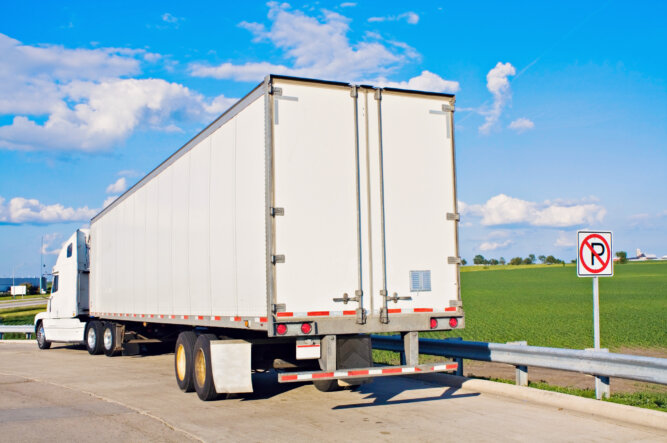What Truckers Should Know About Harvest Season

What are you waiting for?
Make more money starting now.
Harvest season creates a lot of opportunities for truckers to make good money hauling produce and crops. In agricultural areas, high demand for reefer carriers can boost freight rates, and truckers who plan can follow the different harvest seasons from state to state to keep the cash flowing.
Route planning is a big part of profitability during the harvest months. We uncover what you should know about seasonal routes, compliance requirements, and how to prepare your truck (and yourself) for this busy time.
Freight lane options during harvest season
For shippers and brokers, the top priority is getting those fresh fruits, vegetables, and grains to their destination as fast as possible, without any damage, and before they spoil. So they may use a combination of freight lanes to get the job done — including full and partial shipments, short hauls, and last-mile loads, for example.
Crops that have a longer shelf life, like grains and corn, are suitable for long-haul, point-to-point deliveries. So, even if you don’t have a reefer truck for those urgent, short hauls, you still might be able to haul crops.
FMCSA hours of service exceptions
During harvest season, there are exceptions to HOS requirements for drivers hauling “agricultural commodities” (fresh produce, livestock, etc.). If you pick up a load from the source — like a farm or warehouse — you are exempt from HOS rules and don’t have to log hours if you’re within 150 miles of the source.
So, for example:
- You pick up a load of strawberries from a farm and deliver it to a store 200 miles away, but you only need to log your time for the last 50 miles of the trip.
- When you pick up a load of soybeans from a warehouse and deliver it to a wholesaler 40 miles away, then return to the warehouse for a second load, you don’t need to log any of that time. Logging is only required if you haul a non-agricultural load on your return trip..
Interstate trucking compliance
If you want to haul goods across state lines, or across the border of Canada and Mexico, you need an interstate operating authority and a USDOT Number. You also need to complete your Unified Carrier Registration.
When you plan to work in a new-to-you region, take some time to research:
- Speed limits for heavy trucks
- Speed limits for specific routes
- Insurance requirements for trucks
- Weigh station rules
Also, look into tolls you may encounter and how to pay them. If you have a toll pass transponder, make sure it’s compatible with tolls in the states where you’ll be driving.
Delays
Harvest season creates a lot of local and regional truck traffic. And when harvest time coincides with major holidays, road construction projects, or peak travel days, delays may be unavoidable.
When planning routes, allow extra time to account for traffic congestion. Leverage transportation management systems (TMS) to communicate delays to shippers and brokers.
Fuel costs
Expect to spend more than usual on fuel, especially if you’re driving a reefer. To save money at the pump, consider downloading an app that shows you where the lowest prices are, or use a fuel card that awards points for purchases.
You can also negotiate fuel surcharges with shippers and carriers to help prevent incurring a loss if fuel prices increase.
Staying safe on the road
Always keep safety in mind when you’re working long hours in unfamiliar areas.
Rest
It’s important to stay alert and give yourself time to rest. A lot of agricultural areas are remote, without many spots to stop for a break. So if you’ve been on the road a while and see a rest stop or truck stop, pull over and take a break, even if you don’t feel tired. It’s never a bad idea to get out of your cab and stretch!
Even if you’re capitalizing on the HOS exception for agricultural loads, try to stick to a regular sleep schedule. Lack of sleep can impair reaction time, coordination, and judgment — all of which truckers need when behind the wheel.
Maintain your truck
Transporting crops and produce over long distances puts a lot of wear and tear on trucks. Thoroughly inspect your truck before harvest season and at the end of every day. Pay particular attention to the belts, hoses, and tires, and check for any coolant leaks. (Use our pre-trip checklist as a guide.)
Prepare an emergency kit
You probably have an emergency kit already, but think about what you might need if your truck breaks down on an isolated rural road in the summer.
Here are some items to add to your kit:
- Water (one gallon per person, per day)
- High-protein shelf-stable snacks
- Sunscreen
- A rain poncho or umbrella
- Extra flares
- Reflective, high-vis vest (for nighttime roadside repairs)
Let a load board do the work for you
With the Truckstop Load Board, you can find the best rates, partner with trusted brokers and shippers, and plan every route for maximum efficiency. Plus, you can see real-time spot rates, so you know what to charge during harvest season, or any time of year.
With the user-friendly Truckstop Load Board, which includes the Truckstop Go™ mobile app and Load Alert Notifications, you can book loads instantly, factor loads from anywhere, and negotiate with confidence. Get in touch, and we’ll show you how to make the most profits during harvest season this year.
Get helpful content delivered to your inbox.
Sign up today.
Find high-quality loads fast, get higher rates on every haul, and access tools that make your job easier at every turn.






